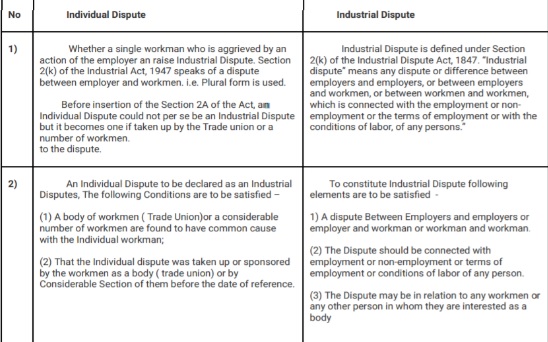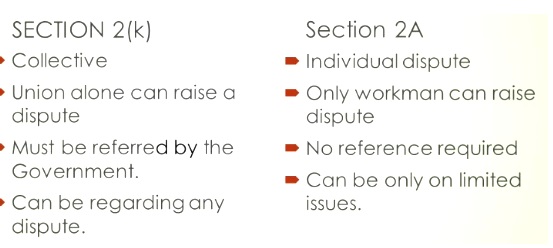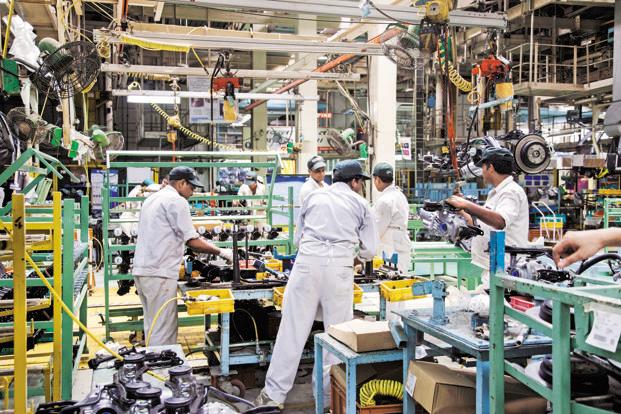In this article, Kabir Jaiswal discusses rights of an individual workman to raise an industrial dispute under the ID Act.
Can an individual dispute become an industrial dispute?
Before the introduction of Section 2-A of the Act, an individual dispute could not in itself be an industrial dispute, but it could become one if the trade union or a number of workers had been involved. The Supreme Court and the majority of Industrial Tribunals held that a dispute raised by a dismissed employee would not be treated as an industrial dispute unless it is supported by a trade union or by a body or Section of a workman.

In a landmark case of Workmen of Dimakuchi Tea Estate v. The Management of Dimakuchi Tea Estate SC identified two tests to determine whether a dispute was industrial or individual. They are-
- A real dispute that can be resolved by relief from one party to another.
- The person for whom the dispute arises must be one in whose employment, non- employment, working conditions or working conditions the parties to the dispute have a direct or substantial interest and this must depend on the facts and circumstances of each case.
- Section 2A does not state that all individual disputes are industrial disputes. It is only when a dispute relates to a discharged, dismissed retrenched or terminated worker that it is treated as an industrial dispute.
- If the dispute or difference relates to some other matter, e.g. the payment of a bonus/gratuity, etc., then the test laid down in court decisions would have to be met.

Conditions under which an individual dispute becomes an industrial dispute
SC held that an individual dispute could be transformed into an industrial dispute if
- it was sponsored by a trade union or
- if it was sponsored by a significant number of workers.
1.→In order to make an individual dispute into an industrial dispute, it must be taken up by a union of employees of the establishment and, where no such union exists, it can be married by any union of workers employed in similar trade.
2.→With regard to the second condition, if an individual dispute between a worker is dealt with by a considerable number of workers of the same establishment, it becomes an industrial dispute. The court admitted that the term ” number appreciable” does not mean a majority of the workers.

Click Here
Time to raise Industrial Discrepancies
Delay to raise an industrial dispute is not a bar to a dispute ‘s reference. In Guest Keen, Williams Pvt. Ltd., Calcutta v. P.J. Sterling SC stated that the Tribunal would definitely take this fact into account when dealing with the merits of the dispute if a dispute arises after a considerable delay that is not reasonably explained.
How can an individual workman raise an industrial dispute
1. Through Grievance Settlement Authority [Sec. 9 (c)]
- This section is included in Chapter II B of the Act. Under this section, the employer shall provide a grievance settlement authority in accordance with the rules laid down in that name under this Act in respect of each industrial establishment in which fifty or more workers are employed or have been employed on any day in the preceding twelve months.
- In order to resolve disputes arising from individual grievances, each industrial establishment employing 20 or more workers shall have one or more grievance redress committee.
- The Grievance Redress Committee may complete its proceedings within 45 days of receipt by or on behalf of the aggrieved Party of a written request.
- The employee who is grieved by the decision of the Grievance Redressal Committee may prefer an appeal to the employer against the decision of the Grievance Redressal Committee and the employer shall dispose of the decision within one month of the date of receipt of that appeal.
2. Through Trade Union
- Chapter III of the 1926 Trade Union Act, sections 15 to 28 of the 1926 Trade Union Act lays down provisions relating to the rights and obligations of registered trade unions.
- Right to represent- If the employee gives written permission to represent, a trade union may make representations on behalf of the employee or individual dispute. A trade union may make presentations with that authorization before any consolation officer, industrial court or labor court.
- Right to sue– A trade union registered is a legal entity and can, therefore, sue the employer or anyone else. He may argue before any labor court, authority, the court in his own name and on behalf of his members.
In Bombay Union of Journalists v. The Hindu Further reduction of the industrial dispute scope. In this case, the Bombay Union of Journalists, of whom the Workers ‘ Union was a member, raised a workers ‘ dispute. The Bombay Journalists Union was not a union of one job, but of all employees in the Bombay journalism industry. Its members were none of the Hindu employees. SC held the dispute to be individual rather than industrial.
In Workmen of Dharampal Premchand v. M/S Dharampal Premchand out of the 45 workers, 18 were rejected. There was no workers union. The court said that a considerable number of workers are involved in this dispute and can, therefore, be called an industrial dispute.SC thus relaxed the requirement that an individual dispute be considered an industrial dispute and thus overruled the case of the Bombay Union of Journalists. The net effect of the above decisions is that an individual employee who is not supported by a significant number of employees or unions has no remedy under the Industrial Disputes Act, 1947.
Workmen of Indian Express Newspapers Ltd. v. Management Indian Express Newspapers A dispute concerning two Indian Express Newspapers Ltd workers was raised by the Delhi Union of Journalists, which was an external union. About 25 percent of the Indian Express working journalists were members of that union. But there was no union of Indian Express journalists. It was held that the Delhi Union of Journalists had a representative character. The working journalists used Indian Express and the dispute thus became an industrial dispute.
A dispute is an industrial dispute even if it is sponsored by a union that is not registered but not unrelated to the employer or industry concerned. (Express Newspapers (Private) Ltd. v. First Labour Court, West Bengal & Others )
3. Through the Labour Court
Labour Court [Sec. 7]: The appropriate government is empowered to establish one or more Labor Courts. Its function is to settle industrial disputes concerning any matter specified in the second schedule.
The Second Schedule deals with matters within the competence of the Labor Courts:
- the legality of an order placed under standing orders by an employer;
- Use and interpretation of standing orders;
- Discharge or dismissal of workers including the reinstatement of workers who were wrongly dismissed or the granting of relief;
- Cancelation of any customary grant or privilege;
- Illegality or otherwise of a strike or lock-out; and
- According to [Sec.10 (1) (c)] Dispute not affecting more than 100 workers may be referred to the labor court on matters specified in the THIRD SCHEDULE.
- According to [Sec.10 (2)] Where parties to the industrial dispute apply to the government to refer the dispute to the labor court and submit a reference to the labor courts if satisfied by the government.
- According to [Sec.10 (6)] No Labor Court or Tribunal shall have jurisdiction to adjudicate any matter before the National Tribunal to be adjudicated.
- The adjudication process begins after the matter has been referred to any CGIT- cum- Labour Court. At the end of the proceedings, the Chairman gives an award. The Labor Ministry under Section 17 of the I.D. The Act publishes the award in the Official Gazette within 30 days of the date on which the award is received.
What are the possible remedies an individual workman can seek in any of the above forums?
Cordial relations between employer and employees should be maintained in the interests of the industry in particular and the national economy in general. The following methods of settling industrial disputes are provided for in the Act to ensure cordial labor-management relations and to achieve industrial harmony:
1) Collective Bargaining – Collective bargaining or negotiation is one of the ways in which industrial disputes are resolved. It plays an important role in fostering relationships between labor management and industrial harmony. Collective bargaining is a process/method by which wage problems and employment conditions are resolved in a friendly, peaceful and voluntary manner between labor and management.
2) Conciliation – Conciliation is a process through which a third party persuades parties to reach a friendly solution to the industrial dispute. This third party is called the conciliation officer of the Council of Conciliation.’ Sections 4 and 5 of the Act provide for the appointment of the Conciliation Officer and the formation of the Council.
3) Voluntarily Arbitration – The term ” arbitration” simply means ” solving or resolving a dispute outside the court.” The parties to the dispute may refer the dispute /matters on in whom they have faith to propose a friendly solution without going to the Court of Law.
Such a person who acts as a mediator between the disputants is called an arbitrator. The decision of the parties that binds the parties is called the ” Award”.
Arbitration is thus a judicial process in which one or more external parties make a binding decision on the basis of the merits of the conflict. Section 10-A of the industrial dispute law of 1947 confers the power to enter into an arbitration agreement on the parties. The agreement shall be in prescribed form and the name/ name of the arbitrator or arbitrator shall be specified.
4) Adjudication – If an industrial dispute cannot be settled either through negotiations or through the conciliation machinery or through voluntary arbitration, the final stage to which an industrial dispute can be settled is the arbitration or compulsory arbitration, which provides for government references to statutory bodies such as the Labor Court or the Industrial Tribunal or the National Court.
Section 7, 7-A and 7-B of the Industrial disputes Act, 1947 provide for the constitution of Labour Court, Industrial Tribunal and Labour Tribunal respectively.
Forums to seek remedies
1. Grievance Settlement Machinery
[Sec.19] Period of operation of settlements and awards.
- A settlement shall enter into force on the date agreed by the parties to the dispute and, if no date is agreed, on the date on which the parties to the dispute sign a settlement memorandum.
- An award shall remain in operation for a period of one year from the date on which the award is enforceable pursuant to section 17A: provided that the government can reduce that period and fix the period it deems appropriate
- The appropriate Government may, before the expiry of the said period, extend the period of operation by any period not exceeding one year at a time as it thinks fit, so however, that the total period of operation of an award does not exceed three years from the date on which it came into operation.
2.Through the Labour Court
- [Sec.16(2)]– The award of a Labor Court or a National Tribunal shall be written and signed by its Chairman.
- [Sec.17(1)]-Any arbitration award and any award of a Labor Court, Tribunal or National Tribunal shall be published in such manner as the appropriate Government considers appropriate within 30 days of the date of its receipt by the appropriate Government.
- [Sec.17 (2)]-The award issued shall be final and shall not in any way be called into question by any Court.
- [Sec.17A (1)]– The award issued shall be final and shall not in any way be called into question by any Court.
- [Sec.17A (3)] – Any award as rejected or modified laid before the legislature of state or parliament shall become enforceable on the expiry of 15 days from the date on which is so laid.
- The declared award shall be enforceable on the specified date if no declared award is enforceable under the above rules.
 Serato DJ Crack 2025Serato DJ PRO Crack
Serato DJ Crack 2025Serato DJ PRO Crack










 Allow notifications
Allow notifications



